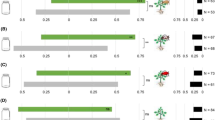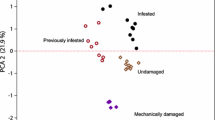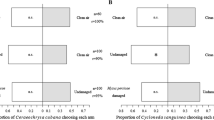Abstract
Olfactory orientation by aphids is guided by specific volatile blends released from their hosts. Host plants that co-exist with other plants may be less attractive for aphids due to volatile interactions between neighboring plants which can lead to changes in their volatile emissions. These changes in host plant volatile profiles induced by interactions between undamaged plants could be used to manage aphid populations in crops. When potato plants are exposed to volatiles from onion plants, the volatile profile of potato changes in relation to that of unexposed plants with consistently greater quantities of two terpenoids released. We examined the host plant searching behavior of aphids and showed that induced changes in plant volatile emissions affect aphid behavior. We assessed olfactory responses of winged and wingless aphids, Myzus persicae Sulzer (Hemiptera: Aphididae) to the changed volatile emissions. Both morphs were significantly less attracted to odors of potato plants that had been exposed to volatiles from onion than to odors of unexposed potato plants. Further, both morphs were significantly less attracted to synthetic blends mimicking volatiles emitted by onion-exposed potato plants than to blends mimicking non-exposed controls, and to single compounds emitted in greater quantities by exposed potato. Aphid morphs were repelled differently depending on the concentration of odor sources; winged aphids responded to higher doses than did wingless aphids. The aphid responses to changes in plant volatile profiles induced by neighboring plants may facilitate refinement of habitat manipulation strategies (e.g., intercropping) for integrated pest management to reduce aphid occurrence in crops.





Similar content being viewed by others
References
Alvarez AE, Garzo E, Verbeek M, Vosman B, Dicke M, Tjallingii WF (2007) Infection of potato plants with potato leafroll virus changes attraction and feeding behaviour of Myzus persicae. Entomol Exp Appl 125:135–144
Amarawardana L, Bandara P, Kumar V, Pettersson J, Ninkovic V, Glinwood R (2007) Olfactory response of Myzus persicae (Homoptera: Aphididae) to volatiles from leek and chive: potential for intercropping with sweet pepper. Acta Agric Scand B-S P 57:87–91
Arimura G, Matsui K, Takabayashi J (2009) Chemical and molecular ecology of herbivore-induced plant volatiles: proximate factors and their ultimate functions. Plant Cell Physiol 50:911–923
Beyaert I, Wäschke N, Scholz A, Varama M, Reinecke A, Hilker M (2010) Relevance of resource-indicating key volatiles and habitat odour for insect orientation. Anim Behav 79:1077–1086
Blackman RL (1990) Specificity in aphid/plant genetic interaction, with particular attention to the role of the alate colonizer. In: Campbell RK, Eikenbary RD (eds) Aphid-plant genotype interactions. Elsevier, Amsterdam, pp 251–274
Blackman RL, Eastop VF (2000) Aphids on the world’s crops: an identification and information guide, 2nd edn. Wiley, Chichester
Boquel S, Giordanengo P, Ameline A (2011) Divergent effects of PVY-infected potato plant on aphids. Eur J Plant Pathol 129:507–510
Bruce TJA, Pickett JA (2011) Perception of plant volatile blends by herbivorous insects- finding the right mix. Phytochemistry 72:1605–1611
Dahlin I, Ninkovic V (2013) Aphid performance and population development on their host plants is affected by weed—crop interactions. J Appl Ecol 50:1281–1288
Degenhardt J, Gershenzon J (2000) Demonstration and characterisation of (E)-nerolidol synthase from maize: a herbivore-inducible terpene synthase participating in (3E)-4, 8-dimethyl-1, 3 7-nonatriene biosynthesis. Planta 210:815–822
Dixon AFG (1985) Resource tracking: mechanism-polyphenism. In: Dixon AFG (ed) Aphid ecology. Chapman & Hall, London, pp 100–127
Egger B, Koschier EH (2014) Behavioural responses of Frankliniella occidentalis Pergande larvae to methyl jasmonate and cis-jamone. J Pest Sci 87:53–59
Eigenbrode SD, Ding H, Shiel P, Berger PH (2002) Volatiles from potato plants infected with potato leafroll virus attract and arrest the virus vector, Myzus persicae (Homoptera: Aphididae). P Roy Soc Lond B Biol 269:455–460
Finch S, Collier RH (2012) The influence of host and non-host companion plants on the behaviour of pest insects in field crops. Entomol Exp Appl 142:87–96
Glinwood R, Ninkovic V, Pettersson J, Ahmed E (2004) Barley exposed to aerial allelopathy from thistles (Cirsium ssp.) becomes less acceptable to aphids. Ecol Entomol 29:1–8
Glinwood R, Ninkovic V, Pettersson J (2011) Chemical interaction between undamaged plants-effects on herbivores and natural enemies. Phytochemistry 72:1683–1689
Gouinguene SP, Turlings TCJ (2002) The effects of abiotic factors on induced volatile emissions in corn plants. Plant Physiol 129:1296–1307
Hardie J, Visser JH, Piron PGM (1994) Perception of volatiles associated with sex and food by different adult forms of the black-bean aphid, Aphid fabae. Physiol Entomol 19:278–284
Hegde M, Oliveira JN, Da Costa JG, Bleicher E, Santana AEG, Bruce TJA, Caulfield J, Dewhirst SY, Woodcock CM, Pickett JA, Birkett MA (2011) Identification of semiochemicals released by cotton, Gossypium hirsutum, upon infestation by the cotton aphid, Aphis gossypii. J Chem Ecol 37:741–750
Hori M (1999) Role of host plant odors in the host finding behaviors of aphids. Appl Entomol Zool 34:293–298
Kellner M, Kolodinska Brantestam A, Åhman I, Ninkovic V (2010) Plant volatiles induced aphid resistance in barley cultivars is related to cultivar age. Theor Appl Genet 121:1133–1139
Klingauf FA (1987) Host plant finding and acceptance. In: Minks AK, Harrewijn P (eds) Aphids: their biology, natural enemies and control. Elsevier, Amsterdam
Kos M, Houshyani B, Overeem A-J, Bouwmeester HJ, Weldegergis BT, van Loon JJA, Dicke M, Vet LEM (2013) Genetic engineering of plant volatile terpenoids: effects on a herbivore, a predator and a parasitoid. Pest Manag Sci 69:302–311
Le Guigo P, Rolier A, Le Corff J (2012) Plant neighborhood influences colonization of Brassicaceae by specialist and generalist aphids. Oecologia 169:753–761
Markovic D, Glinwood R, Olsson U, Ninkovic V (2014) Plant response to touch affects the behaviour of aphids and ladybirds. Arthropod Plant Interact. doi:10.1007/s11829-014-9303-6
Ngumbi E, Eigenbrode SD, Bosque-Perez NA, Ding H, Rodriques A (2007) Myzus persicae is arrested more by blends than by individual compounds elevated in headspace of PLRV-infected potato. J Chem Ecol 33:1733–1747
Ninkovic V (2003) Volatile communication between barley plants affects biomass allocation. J Exp Bot 54:1931–1939
Ninkovic V, Åhman I (2009) Aphid acceptance of Hordeum genotypes is affected by plant volatile exposure and is correlated with aphid growth. Euphytica 169:177–185
Ninkovic V, Olsson U, Pettersson J (2002) Mixed barley cultivars affects aphid host plant acceptance in field experiments. Entomol Exp Appl 102:177–182
Ninkovic V, Glinwood R, Dahlin I (2009) Weed-barley interactions affect plant acceptance by aphids in laboratory and field experiments. Entomol Exp Appl 133:38–45
Ninkovic V, Dahlin I, Vucetic A, Petrovic-Obradovic O, Glinwood R, Webster B (2013) Volatile exchange between undamaged plants—a new mechanism affecting insect orientation in intercropping. PLoS One. doi:10.1371/journal.pone.0069431
Park KC, Hardie J (2004) Electrophysiological characterisation of olfactory sensilla in the black bean aphid, Aphis fabae. J Insect Physiol 50:647–655
Park KC, Elias D, Donato B, Hardie J (2000) Electroantennogram and behavioural responses of different forms of the bird cherry-oat aphid, Rhopalosiphum padi, to sex pheromone and a plant volatile. J Insect Physiol 46:597–604
Pettersson J, Tjallingii WF, Hardie J (2007) Host-plant selection and feeding. In: van Emden H, Harrington R (eds) Aphids as crop pests. CAB International, Wallingford
Pickett JA, Glinwood R (2007) Chemical Ecology. In: van Emden H, Harrington R (eds) Aphids as crop pests. CAB International, Wallingford
Pickett JA, Wadhams LJ, Woodcock CM, Hardie J (1992) The chemical ecology of aphids. Annu Rev Entomol 37:67–90
Piesik D, Łyszczarz A, Tabaka P, Lamparski R, Bocianowski J, Delaney KJ (2010) Volatile induction of three cereals: influence of mechanical injury and insect herbivory on injured plants and neighbouring uninjured plants. Ann Appl Biol 157:425–434
Pophof B, Stange G, Abrell L (2005) Volatile organic compounds as signals in a plant-herbivore system: electrophysiological responses in olfactory sensilla of the moth Cactoblastis cactorum. Chem Senses 30:51–68
Powell H, Hardie J (2001) The chemical ecology of aphid host alternation: how do return migrants find the primary host plant? Appl Entomol Zool 36:259–267
Quiroz A, Niemeyer HM (1998) Olfactometer-assed responses of aphid Rhopalosiphum padi to wheat and oat volatiles. J Chem Ecol 24:113–124
Rajabaskar D, Ding H, Wu Y, Eigenbrode SD (2013a) Behavioral responses of green peach aphid, Myzus persicae (Sulzer), to the volatile organic compound emissions from four potato varieties. Am J Potato Res 90:171–178
Rajabaskar D, Wu Y, Bosque-Pérez NA, Eigenbrode SD (2013b) Dynamics of Myzus persicae arrestment by volatiles from potato leafroll virus-infected potato plants during disease progression. Entomol Exp Appl 148:172–181
Randlkofer B, Obermaier E, Hilker M, Meiners T (2010) Vegetation complexity—The influence of plant species diversity and plant structures on plant chemical complexity and arthropods. Basic Appl Ecol 11:383–395
Silva AX, Jander G, Samaniego H, Ramsey JS, Figueroa CC (2012) Insecticide resistance mechanims in the green peach aphid Myzus persicae (Hemiptera: Aphididae) I: a transcriptomic survey. PLoS One 7:e36366
StatSoft Inc (2011) STATISTICA (data analysis software system), version 10.0 StatSoft, Tulsa, OK, USA
Sun YP, Zhao LJ, Sun L, Zhang SG, Ban LP (2012) Immunolocalization of odorant-binding proteins on antennal chemosensilla of the peach aphid Myzus persicae (Sulzer). Chem Senses. doi:10.1093/chemse/bjs093
Vargas RR, Troncoso AJ, Tapia DH, Olivares-Donoso R, Niemeyer HM (2005) Behavioural differences during host selection between alate virginoparae of generalist and tobacco-specialist Myzus persicae. Entomol Exp Appl 116:43–53
Verheggen FJ, Haubruge E, De Moraes CM, Mescher MC (2013) Aphid responses to volatile cues from turnip plants (Brassica rapa) infested with phloem-feeding and chewing herbivores. Arthropod Plant Interact 7:567–577
Webster B (2012) The role of olfaction in aphid host location. Physiol Entomol 37:10–18
Webster B, Bruce T, Pickett J, Hardie J (2010) Volatiles functioning as host cues in a blend become nonhost cues when presented alone to the black bean aphid. Anim Behav 79:451–457
Wiktelius S (1989) Migration of apterous Rhopalosiphum padi. IOBC WPRS Bull 12:1–6
Yan FS, Visser JH (1982) Electroantennogram responses of the cereal aphid Sitobion avenae to plant volatile components. In: Proceedings 5th international symposium on insect–plant relationships. Pudoc, Wageningen
Acknowledgments
We gratefully acknowledge Jan Pettersson for useful discussions and valuable comments on the manuscript. We thank Elham Ahmed and Erika Qvarfordt (Swedish University of Agricultural Sciences, Department of Ecology) for their help in the laboratory and Dimitrije Markovic for making the illustration figure. We thank two anonymous reviewers for their comments and encouragements. This work was supported by the Swedish Foundation for Strategic Environmental Research (MISTRA) through the PlantComMistra program, the Ministry of Education, Science and Technological Development of the Republic of Serbia (Project No. III 46008), and the Carl Trygger Foundation for Scientific Research.
Author information
Authors and Affiliations
Corresponding author
Additional information
Communicated by C. Cutler.
Rights and permissions
About this article
Cite this article
Dahlin, I., Vucetic, A. & Ninkovic, V. Changed host plant volatile emissions induced by chemical interaction between unattacked plants reduce aphid plant acceptance with intermorph variation. J Pest Sci 88, 249–257 (2015). https://doi.org/10.1007/s10340-014-0625-z
Received:
Revised:
Accepted:
Published:
Issue Date:
DOI: https://doi.org/10.1007/s10340-014-0625-z




